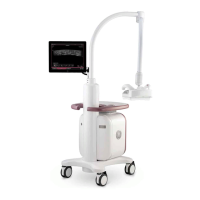continued
HEAT OUTPUT
Stand by
Moderate Use (8
cases / a 10 hour
day)
Typical Use (13
cases / a 10 hour
day)
Maximum Use
(maximum peak
power during ex-
am)
Room Core System kW BTU/hr kW BTU/hr kW BTU/hr kW BTU/hr
Note (3): For UPS 20 kVA option refer to Fluoro UPS Option on page 133
Note (4): The 2nd optional LD monitor is not necessarily in the control room. It may be installed in the exam room
(outside patient vicinity).
CAUTION
Make sure there is a ventilation air flow, preferably ensured by natural air flow,
otherwise by enforced ventilation, so that hydrogen concentration is below 1%
(according to Standard IEC 62040-1-2).
Fluoro UPS Option
Figure 4-1
The heat produced by the UPS is transferred to the environment by its ventilation. Cooling air enters the
cabinets through the air inlet (grids) located at the bottom and exhausted through the outlet on the roof.
A suitable ventilation or cooling system must be installed to extract the heat from the UPS room.
NOTICE
Do not put anything on the top of the cabinet.
If the UPS is placed on a raised floor, the airflow for UPS cooling should enter from underneath the UPS,
through the appropriate aperture on the raised floor.
If the UPS runs in a dusty environment, we recommend strongly to install filters on the air inlet of the UPS
room. In this case it should be considered that these filters can cause reduced speed at the air inlet.
The size of the air inlet has therefore to be dimensioned accordingly.
Contact your Local Distributor or one of the Service Centre, which will help you to find valuable solutions.
Environmental Requirements
5750182-1EN 3
Innova
TM
IGS 6
133

